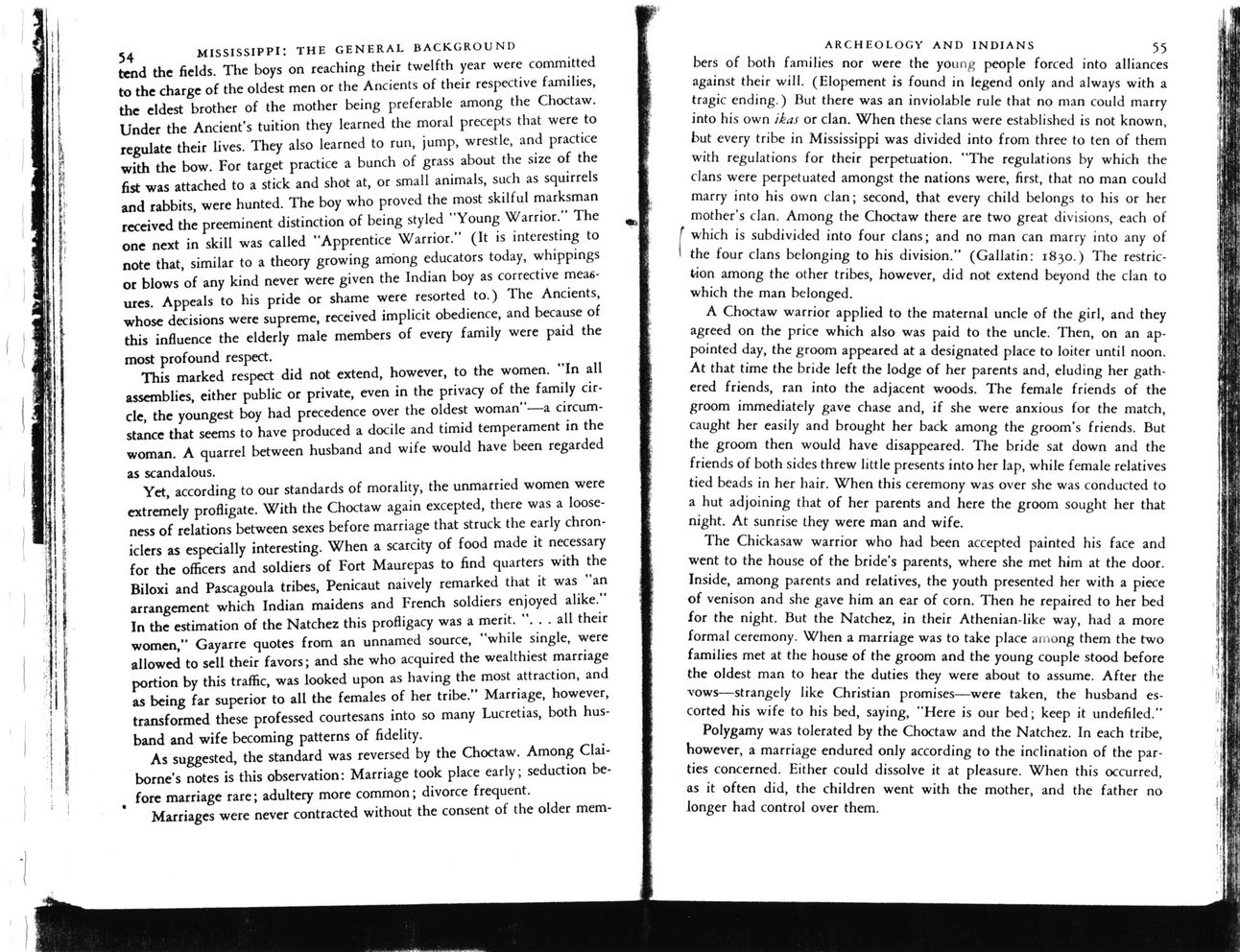This text was obtained via automated optical character recognition.
It has not been edited and may therefore contain several errors.
54 MISSISSIPPI: THE GENERAL BACKGROUND tend the fields. The boys on reaching their twelfth year were committed to the charge of the oldest men or the Ancients of their respective families, the eldest brother of the mother being preferable among the Choctaw. Under the Ancient’s tuition they learned the moral precepts that were to regulate their lives. They also learned to run, jump, wrestle, and practice with the bow. For target practice a bunch of grass about the size of the fist was attached to a stick and shot at, or small animals, such as squirrels and rabbits, were hunted. The boy who proved the most skilful marksman received the preeminent distinction of being styled "Young Warrior.” The one next in skill was called "Apprentice Warrior.” (It is interesting to note that, similar to a theory growing among educators today, whippings or blows of any kind never were given the Indian boy as corrective measures. Appeals to his pride or shame were resorted to.) The Ancients, whose decisions were supreme, received implicit obedience, and because of this influence the elderly male members of every family were paid the most profound respect. This marked respect did not extend, however, to the women. "In all assemblies, either public or private, even in the privacy of the family circle, the youngest boy had precedence over the oldest woman”—a circumstance that seems to have produced a docile and timid temperament in the woman. A quarrel between husband and wife would have been regarded as scandalous. Yet, according to our standards of morality, the unmarried women were extremely profligate. With the Choctaw again excepted, there was a looseness of relations between sexes before marriage that struck the early chroniclers as especially interesting. When a scarcity of food made it necessary for the officers and soldiers of Fort Maurepas to find quarters with the Biloxi and Pascagoula tribes, Penicaut naively remarked that it was "an arrangement which Indian maidens and French soldiers enjoyed alike.” In the estimation of the Natchez this profligacy was a merit. ". . . all their women," Gayarre quotes from an unnamed source, "while single, were allowed to sell their favors; and she who acquired the wealthiest marriage portion by this traffic, was looked upon as having the most attraction, and as being far superior to all the females of her tribe.” Marriage, however, transformed these professed courtesans into so many Lucretias, both husband and wife becoming patterns of fidelity. As suggested, the standard was reversed by the Choctaw. Among Claiborne’s notes is this observation: Marriage took place early; seduction before marriage rare; adultery more common; divorce frequent. Marriages were never contracted without the consent of the older mem- ARCHEOLOGY AND INDIANS 55 bers of both families nor were the young people forced into alliances against their will. (Elopement is found in legend only and always with a tragic ending.) But there was an inviolable rule that no man could marry into his own ikas or clan. When these clans were established is not known, but every tribe in Mississippi was divided into from three to ten of them with regulations for their perpetuation. "The regulations by which the clans were perpetuated amongst the nations were, first, that no man could marry into his own clan; second, that every child belongs to his or her mother’s clan. Among the Choctaw there are two great divisions, each of which is subdivided into four clans; and no man can marry into any of the four clans belonging to his division.” (Gallatin: 1830.) The restriction among the other tribes, however, did not extend beyond the clan to which the man belonged. A Choctaw warrior applied to the maternal uncle of the girl, and they agreed on the price which also was paid to the uncle. Then, on an appointed day, the groom appeared at a designated place to loiter until noon. At that time the bride left the lodge of her parents and, eluding her gathered friends, ran into the adjacent woods. The female friends of the groom immediately gave chase and, if she were anxious for the match, caught her easily and brought her back among the groom's friends. But the groom then would have disappeared. The bride sat down and the friends of both sides threw little presents into her lap, while female relatives tied beads in her hair. When this ceremony was over she was conducted to a hut adjoining that of her parents and here the groom sought her that night. At sunrise they were man and wife. The Chickasaw warrior who had been accepted painted his face and went to the house of the bride’s parents, where she met him at the door. Inside, among parents and relatives, the youth presented her with a piece of venison and she gave him an ear of corn. Then he repaired to her bed for the night. But the Natchez, in their Athenian-like way, had a more formal ceremony. When a marriage was to take place among them the two families met at the house of the groom and the young couple stood before the oldest man to hear the duties they were about to assume. After the vows—strangely like Christian promises—were taken, the husband escorted his wife to his bed, saying, "Here is our bed; keep it undefiled.” Polygamy was tolerated by the Choctaw and the Natchez. In each tribe, however, a marriage endured only according to the inclination of the parties concerned. Either could dissolve it at pleasure. When this occurred, as it often did, the children went with the mother, and the father no longer had control over them.

Hancock County Early WPA-Guide-to-Mississippi-(041)